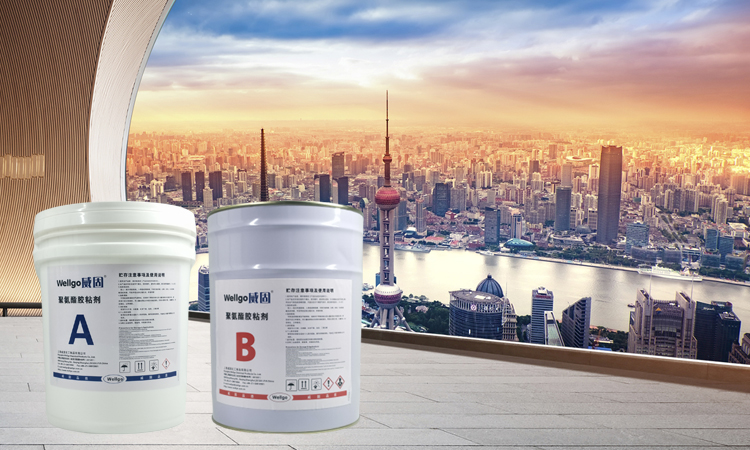Polyurethane adhesive is a type of polyurethane resin that is currently developing rapidly. It is an important component with excellent performance and has been widely used in many aspects. It is one of the eight important varieties of synthetic adhesives and is suitable for various structural bonding fields.
You may be curious. The bonding strength of polyurethane adhesive is so strong and the types of bonding materials are so wide. So how exactly does it bond various materials together? The following summarizes the bonding mechanism of polyurethane adhesive into the following categories based on the different types of polyurethane adhesive bonding materials:

1. Polyurethane adhesiveatAdhesion of metal, glass, ceramics, etc.
Metal, glass and other materials have high surface tension and are high-energy surfaces. The cured polyurethane adhesive contains urethane bonds and urea bonds with high cohesive energy. Under certain conditions, they can aggregate on the bonding surface to form High surface tension adhesive layer. Generally speaking, the higher the percentage of isocyanate or its derivatives in the adhesive, the greater the surface tension of the adhesive layer, the tougher the adhesive, which can match well with base materials such as metal, and the bonding strength is generally higher.
1. Containing -NCO group The bonding mechanism of adhesive to metal is as follows:
There is generally adsorbed water on the metal surface (even if the metal surface has been polished, there is a trace amount of adsorbed water or metal oxide hydrate), –The urea bond generated by the reaction between NCO and water and the metal oxide are chelated due to hydrogen bonds to form a urea-metal oxide complex. The -NCO group can also form covalent bonds with metal hydrates, etc.
2. In the case of no-NCO, Van der Waals forces and hydrogen bonds are generated between metal surface hydrates and metal atoms and urethane bonds and urea bonds. Polyurethane adhesives based on TDI and MDI contain benzene rings and have redundant electron systems that can form valence bonds with metals. The composition of the metal surface is relatively complex, and the types of various chemical bonds or subvalent bonds (such as hydrogen bonds) formed between it and the polyurethane glue are also complex.
3. Glass, slate, ceramic and other inorganic materials Generally composed of SO2, CaO and Na2O, the surface also contains adsorbed water hydroxyl groups, and the bonding mechanism is roughly the same as that of metal.
2. Polyurethane adhesiveat Plastic rubber bonding
Rubber bonding generally uses polyisocyanate adhesives or polyisocyanate adhesives modified by rubber adhesives. The organic solvents contained in the adhesives can swell the rubber surface. The molecular weight of polyisocyanate adhesives is small and can penetrate into the interior of the rubber surface and interact with the rubber. The active hydrogen present in the molecule reacts to form a covalent bond. In addition, polyisocyanate will also react with moisture to form urea groups or biurets, and when heated and cured, isocyanate will self-polymerize to form a cross-linked structure, which cross-links with the rubber molecular network to form a polymer cross-linked interpenetrating network (IPI), so the adhesive layer has good physical properties. When ordinary polyurethane adhesives are used to bond rubber, good bonding can also occur due to the chemical and physical interactions between the material groups.
Polar groups on the surface of PVC, PET, FRP and other plastics can form hydrogen bonds with urethane bonds, ester bonds, ether bonds and other groups in the adhesive to form joints with a certain bonding strength. Some people think that fiberglass reinforced plastic (FRP) contains -OH groups, and the -OH on the surface reacts with -NCO in the polyurethane adhesive to form chemical adhesion.
Non-polar plastics such asPE, PP, etc. have very low surface polarity. If you use polar polyurethane adhesives to bond, you may encounter difficulties. This problem Surface treatments for polyolefin plastics can be addressed in a variety of ways. There are two commonly used methods to deal withOne method is to use corona treatment to oxidize the surface, thereby increasing the polarity; another method is to use polyisocyanate adhesive as a tackifying coating agent (primer primer) on the surface of the plastic to be adhered. glue). For example, when melting concave extrusion films are extruded and compounded on plastic films such as PET, the bonding strength is not ideal due to the presence of a weak interface layer with a low degree of polymerization on the surface. When using a primer, the polyisocyanate will melt on the hot polyethylene surface. It diffuses upward, thereby strengthening the weak interface layer, making the composite film have very good peel strength.
3. Polyurethane adhesiveat Adhesion of fabrics, wood, etc.
<font face=" Substrates such as fabric and wood are composed of fibers, which have a certain moisture absorption rate and often contain polar bonds such as ether bonds, ester bonds, amide bonds, and carboxyl hydroxyl groups. Water and hydroxyl groups easily react with the –NCO group in the polyurethane adhesive to form strong chemical bonds such as urethane bonds and urea bonds; while the polar groups in the fiber react with the Hydrogen bonds are formed between the polar groups, and the adhesive molecules easily penetrate into the fibers. Polyurethane generally forms strong bonds to these materials.



 微信扫一扫打赏
微信扫一扫打赏
